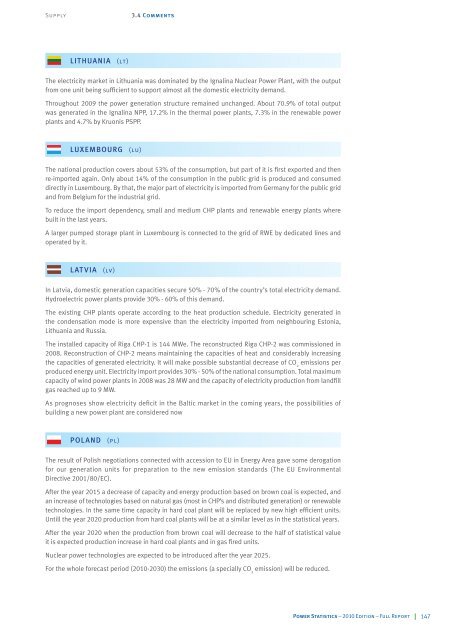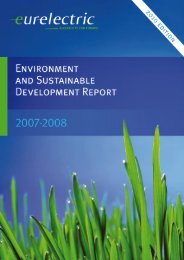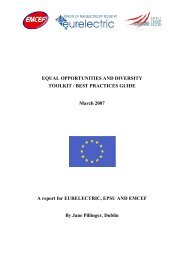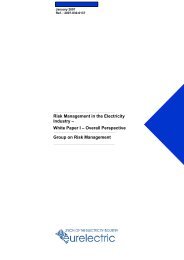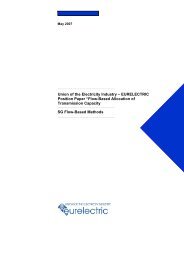Power Statistics - 2010 Edition - Full Report - Eurelectric
Power Statistics - 2010 Edition - Full Report - Eurelectric
Power Statistics - 2010 Edition - Full Report - Eurelectric
You also want an ePaper? Increase the reach of your titles
YUMPU automatically turns print PDFs into web optimized ePapers that Google loves.
Supply 3.4 Comments<br />
LITHUANIA (lt)<br />
The electricity market in Lithuania was dominated by the Ignalina Nuclear <strong>Power</strong> Plant, with the output<br />
from one unit being sufficient to support almost all the domestic electricity demand.<br />
Throughout 2009 the power generation structure remained unchanged. About 70.9% of total output<br />
was generated in the Ignalina NPP, 17.2% in the thermal power plants, 7.3% in the renewable power<br />
plants and 4.7% by Kruonis PSPP.<br />
LUXEMBOURG (lu)<br />
The national production covers about 53% of the consumption, but part of it is first exported and then<br />
re-imported again. Only about 14% of the consumption in the public grid is produced and consumed<br />
directly in Luxembourg. By that, the major part of electricity is imported from Germany for the public grid<br />
and from Belgium for the industrial grid.<br />
To reduce the import dependency, small and medium CHP plants and renewable energy plants where<br />
built in the last years.<br />
A larger pumped storage plant in Luxembourg is connected to the grid of RWE by dedicated lines and<br />
operated by it.<br />
LATVIA (lv)<br />
In Latvia, domestic generation capacities secure 50% - 70% of the country’s total electricity demand.<br />
Hydroelectric power plants provide 30% - 60% of this demand.<br />
The existing CHP plants operate according to the heat production schedule. Electricity generated in<br />
the condensation mode is more expensive than the electricity imported from neighbouring Estonia,<br />
Lithuania and Russia.<br />
The installed capacity of Riga CHP-1 is 144 MWe. The reconstructed Riga CHP-2 was commissioned in<br />
2008. Reconstruction of CHP-2 means maintaining the capacities of heat and considerably increasing<br />
the capacities of generated electricity. It will make possible substantial decrease of CO 2 emissions per<br />
produced energy unit. Electricity import provides 30% - 50% of the national consumption. Total maximum<br />
capacity of wind power plants in 2008 was 28 MW and the capacity of electricity production from landfill<br />
gas reached up to 9 MW.<br />
As prognoses show electricity deficit in the Baltic market in the coming years, the possibilities of<br />
building a new power plant are considered now<br />
POLAND (pl)<br />
The result of Polish negotiations connected with accession to EU in Energy Area gave some derogation<br />
for our generation units for preparation to the new emission standards (The EU Environmental<br />
Directive 2001/80/EC).<br />
After the year 2015 a decrease of capacity and energy production based on brown coal is expected, and<br />
an increase of technologies based on natural gas (most in CHP’s and distributed generation) or renewable<br />
technologies. In the same time capacity in hard coal plant will be replaced by new high efficient units.<br />
Untill the year 2020 production from hard coal plants will be at a similar level as in the statistical years.<br />
After the year 2020 when the production from brown coal will decrease to the half of statistical value<br />
it is expected production increase in hard coal plants and in gas fired units.<br />
Nuclear power technologies are expected to be introduced after the year 2025.<br />
For the whole forecast period (<strong>2010</strong>-2030) the emissions (a specially CO 2 emission) will be reduced.<br />
<strong>Power</strong> <strong>Statistics</strong> – <strong>2010</strong> <strong>Edition</strong> – <strong>Full</strong> <strong>Report</strong> 147


